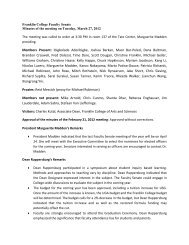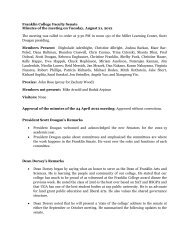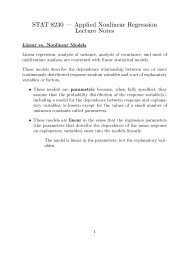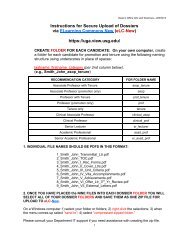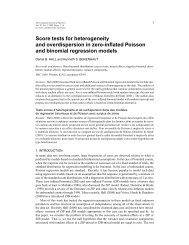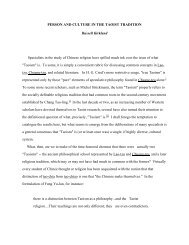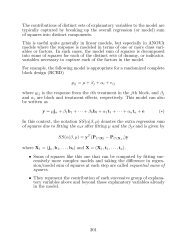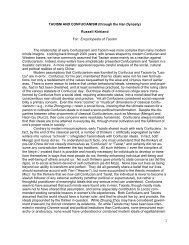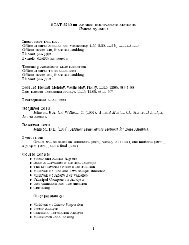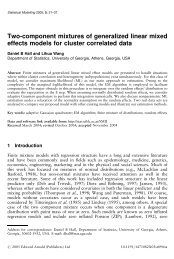Robust Estimation for Zero-Inflated Poisson Regression - Franklin ...
Robust Estimation for Zero-Inflated Poisson Regression - Franklin ...
Robust Estimation for Zero-Inflated Poisson Regression - Franklin ...
Create successful ePaper yourself
Turn your PDF publications into a flip-book with our unique Google optimized e-Paper software.
10 D. B. Hall and J. Shen Scand J StatistTable 3. Simulation results <strong>for</strong> a zero-inflated <strong>Poisson</strong> model with poorlyseparated components, regression structure <strong>for</strong> the mixing probability p,and 5 per cent outliers in yRESMLEParameters Bias MSE Size Bias MSE Sizen = 100γ 1 = −1 0.1385 0.4150 0.05 0.5361 0.5286 0.20γ 2 = −0.5 0.0185 0.3155 0.05 0.1764 0.3142 0.08γ 3 = 0.5 −0.2276 0.7497 0.06 −0.4988 0.7875 0.10β 1 = 0.0 0.3125 0.1626 0.23 0.8265 0.7401 0.92β 2 = 1.0 0.1582 0.0737 0.20 0.3969 0.2115 0.62β 3 = 1.0 −0.1073 0.1294 0.10 −0.3819 0.3104 0.48β 4 = 0.1 −0.0086 0.0145 0.17 −0.0386 0.0189 0.40ζ 0.5391 1.1288n = 200γ 1 = −1 0.1771 0.2318 0.10 0.5616 0.4547 0.38γ 2 = −0.5 0.0133 0.1360 0.07 0.1558 0.1411 0.09γ 3 = 0.5 −0.1663 0.3609 0.07 −0.4171 0.4487 0.13β 1 = 0.0 0.2802 0.1232 0.28 0.8108 0.7236 0.97β 2 = 1.0 0.1699 0.0548 0.27 0.4179 0.2132 0.83β 3 = 1.0 −0.0876 0.0804 0.15 −0.3669 0.2538 0.59β 4 = 0.1 −0.0134 0.0048 0.10 −0.0434 0.0088 0.34ζ 0.3001 0.8284RES, robust expectation-solution; MLE, maximum likelihood estimation;MSE, mean square error.n = 100 and two points <strong>for</strong> n = 200), and replaced the covariate value x 3 by x 3 + 3, leavingthe response y and other covariates unchanged.The results in Table 4 show that RES and ML per<strong>for</strong>m similarly with respect to γ. Thisresult is sensible, as there is only a small amount of contamination in x that is of a <strong>for</strong>m thatdoes not obscure the mixture structure underlying the data. With respect to β and ζ, however,RES has less bias, smaller MSE and closer to nominal size than ML estimation. Generallyspeaking, the usual positive effect of sample size on efficiency is observed.5. ExampleTo illustrate the use of robust methods <strong>for</strong> ZI regression models, we consider data collected byJackson (2004) who investigated factors predictive of youth involvement in adverse incidentsduring residence in Georgia state detention facilities. Data on n = 13,517 youths detainedin the state of Georgia during the period 1 July 2001 to 30 June 2002 were collected fromthe Juvenile Tracking System, a database maintained by the Georgia Department of JuvenileJustice. These data contain in<strong>for</strong>mation on detainees’ involvement in certain types of incidents(e.g. allegations of child abuse, suicide attempts, youth on youth assault, etc.) as wellas characteristics of the child, the facility in which the incident occurred and the nature ofthe detention. Here, we consider models <strong>for</strong> detainees’ involvement in one class of incidentsstudied by Jackson: UOF occurrences. Although some subjects were detained in multiplefacilities over the period covered in the data set, <strong>for</strong> simplicity we restrict attention to eachsubject’s first stay in a detention facility during the period of interest.Table 5 contains a frequency distribution <strong>for</strong> the UOF counts, 94.07 per cent of which are0, and 99.9 per cent of which are ≤ 5. In addition, there are a few especially large counts,including one of 22 that seems particularly extreme. We consider regression models <strong>for</strong> thesedata built from a fairly rich set of covariates, so the marginal distribution of Table 5 gives© 2009 Board of the Foundation of the Scandinavian Journal of Statistics.



